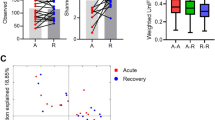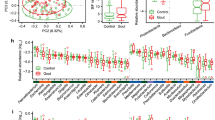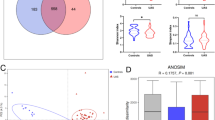Abstract
Humans do not produce uricase, an enzyme responsible for degrading uric acid. However, some bacteria residing in the gut can degrade one-third of the dietary and endogenous uric acid generated daily. New insights based on metagenomic and metabolomic approaches provide a new interest in exploring the involvement of gut microbiota in gout. Nevertheless, the exact mechanisms underlying this association are complex and have not been widely discussed. In this study, we aimed to review the evidence that suggests uric acid extrarenal excretion and gut microbiome are potential risk factors for developing gout. A literature search was performed in PubMed, Web of Science, and Google Scholar using several keywords, including “gut microbiome AND gout”. A remarkable intestinal dysbiosis and shifts in abundance of certain bacterial taxa in gout patients have been consistently reported among different studies. Under this condition, bacteria might have developed adaptive mechanisms for de novo biosynthesis and salvage of purines, and thus, a concomitant alteration in uric acid metabolism. Moreover, gut microbiota can produce substrates that might cross the portal vein so the liver can generate de novo purinogenic amino acids, as well as uric acid. Therefore, the extrarenal excretion of uric acid needs to be considered as a factor in gout development. Nevertheless, further studies are needed to fully understand the role of gut microbiome in uric acid production and its extrarenal excretion, and to point out possible bacteria or bacterial enzymes that could be used as probiotic coadjutant treatment in gout patients.


Similar content being viewed by others
Availability of data and material
Not applicable.
Code availability
Not applicable.
References
Ichida K, Matsuo H, Takada T et al (2012) Decreased extra-renal urate excretion is a common cause of hyperuricemia. Nat Commun 3:764. https://doi.org/10.1038/ncomms1756
Pasut G, Sergi M, Veronese FM (2008) Anti-cancer PEG-enzymes: 30 years old, but still a current approach. Adv Drug Deliv Rev 60:69–78. https://doi.org/10.1016/j.addr.2007.04.018
Casartelli A, Melino VJ, Baumann U et al (2019) Opposite fates of the purine metabolite allantoin under water and nitrogen limitations in bread wheat. Plant Mol Biol 99:477–497. https://doi.org/10.1007/s11103-019-00831-z
Szczurek P, Mosiichuk N, Woliński J et al (2017) Oral uricase eliminates blood uric acid in the hyperuricemic pig model. PLoS ONE 12:e0179195. https://doi.org/10.1371/journal.pone.0179195
Alvarez-Lario B, Macarron-Vicente J (2010) Uric acid and evolution. Rheumatology 49:2010–2015
Ramazzina I, Costa R, Cendron L et al (2010) An aminotransferase branch point connects purine catabolism to amino acid recycling. Nat Chem Biol 6:801–806. https://doi.org/10.1038/nchembio.445
Guo Z, Zhang J, Wang Z et al (2016) Intestinal microbiota distinguish gout patients from healthy humans. Sci Rep 6:20602. https://doi.org/10.1038/srep20602
O’Hara AM, Shanahan F (2006) The gut flora as a forgotten organ. EMBO Rep 7:688–693. https://doi.org/10.1038/sj.embor.7400731
Papakostas K, Frillingos S (2012) Substrate selectivity of YgfU, a uric acid transporter from Escherichia coli. J Biol Chem 287:15684–15695. https://doi.org/10.1074/jbc.M112.355818
Desai J, Steiger S, Anders HJ (2017) Molecular pathophysiology of gout. Trends Mol Med 23:756–768. https://doi.org/10.1016/j.molmed.2017.06.005
Dalbeth N, Gosling AL, Gaffo A, Abhishek A (2021) Gout. Lancet 397:1843–1855. https://doi.org/10.1016/S0140-6736(21)00569-9
Smith E, Hoy D, Cross M et al (2014) The global burden of gout: estimates from the Global Burden of Disease 2010 study. Ann Rheum Dis 73:1470–1476. https://doi.org/10.1136/annrheumdis-2013-204647
Ragab G, Elshahaly M, Bardin T (2017) Gout: an old disease in new perspective—A review. J Adv Res 8:495–511. https://doi.org/10.1016/j.jare.2017.04.008
Kuo C-F, Grainge MJ, Zhang W, Doherty M (2015) Global epidemiology of gout: prevalence, incidence, and risk factors. Nat Rev Rheumatol 11:649–662. https://doi.org/10.1038/nrrheum.2015.91
Vázquez-Mellado J, Cruz J, Guzmán S et al (2006) Severe tophaceous gout. Characterization of low socioeconomic level patients from México. Clin Exp Rheumatol 24:233–238
Kim JW, Kwak SG, Lee H et al (2017) Prevalence and incidence of gout in Korea: data from the national health claims database 2007–2015. Rheumatol Int 37:1499–1506. https://doi.org/10.1007/s00296-017-3768-4
Krishnan E, Lessov-Schlaggar CN, Krasnow RE, Swan GE (2012) Nature versus nurture in Gout: a twin study. Am J Med 125:499–504. https://doi.org/10.1016/j.amjmed.2011.11.010
Misawa K, Hasegawa T, Mishima E et al (2020) Contribution of rare variants of the SLC22A12 gene to the missing heritability of serum urate levels. Genetics 214:1079–1090. https://doi.org/10.1534/GENETICS.119.303006
Smith EUR, Díaz-Torné C, Perez-Ruiz F, March LM (2010) Epidemiology of gout: an update. Best Pract Res Clin Rheumatol 24:811–827. https://doi.org/10.1016/j.berh.2010.10.004
Butler F, Alghubayshi A, Roman Y (2021) The epidemiology and genetics of hyperuricemia and gout across major racial groups: a literature review and population genetics secondary database analysis. J Pers Med 11:231. https://doi.org/10.3390/jpm11030231
Beyl RN, Hughes L, Morgan S (2016) Update on importance of diet in gout. Am J Med 129:1153–1158. https://doi.org/10.1016/j.amjmed.2016.06.040
Kawamura Y, Nakaoka H, Nakayama A, Okada Y, Sakiyama M (2019) Genomewide association study revealed novel loci which aggravate asymptomatic hyperuricaemia into gout. Ann Rheum Dis 78:1430–1437
Li X, Song P, Li J et al (2015) Relationship between hyperuricemia and dietary risk factors in Chinese adults: a cross-sectional study. Rheumatol Int 35:2079–2089. https://doi.org/10.1007/s00296-015-3315-0
Sandoval-Plata G, Morgan K, Abhishek A (2021) Variants in urate transporters, ADH1B, GCKR and MEPE genes associate with transition from asymptomatic hyperuricaemia to gout: results of the first gout versus asymptomatic hyperuricaemia GWAS in Caucasians using data from the UK Biobank. Ann Rheum Dis 80:1220–1226. https://doi.org/10.1136/ANNRHEUMDIS-2020-219796
Maiuolo J, Oppedisano F, Gratteri S et al (2016) Regulation of uric acid metabolism and excretion. Int J Cardiol 213:8–14
Abooali M, Lall GS, Coughlan K et al (2014) Crucial involvement of xanthine oxidase in the intracellular signalling networks associated with human myeloid cell function. Sci Rep 4:6307. https://doi.org/10.1038/srep06307
Kang DH, Johnson RJ (2015) Uric acid metabolism and the kidney. In: Chronic Renal Disease. Academic Press, Cambridge, pp 418–428
Benn CL, Dua P, Gurrell R et al (2018) Physiology of hyperuricemia and urate-lowering treatments. Front Med 5:160. https://doi.org/10.3389/fmed.2018.00160
Kaneko K, Aoyagi Y, Fukuuchi T et al (2014) Total purine and purine base content of common foodstuffs for facilitating nutritional therapy for gout and hyperuricemia. Biol Pharm Bull 37:709–721. https://doi.org/10.1248/bpb.b13-00967
Choi HK, Atkinson K, Karlson EW et al (2004) Purine-rich foods, dairy and protein intake, and the risk of gout in men. N Engl J Med 350:1093–1103. https://doi.org/10.1056/nejmoa035700
Zhang Y, Woods R, Chaisson CE et al (2006) Alcohol consumption as a trigger of recurrent gout attacks. Am J Med 119:800.e13–8. https://doi.org/10.1016/j.amjmed.2006.01.020
Towiwat P, Li ZG (2015) The association of vitamin C, alcohol, coffee, tea, milk and yogurt with uric acid and gout. Int J Rheum Dis 18:495–501. https://doi.org/10.1111/1756-185X.12622
Jamnik J, Rehman S, Blanco Mejia S et al (2016) Fructose intake and risk of gout and hyperuricemia: a systematic review and meta-analysis of prospective cohort studies. BMJ Open 6:e013191. https://doi.org/10.1136/bmjopen-2016-013191
Ayoub-Charette S, Liu Q, Khan TA et al (2019) Important food sources of fructose-containing sugars and incident gout: A systematic review and meta-analysis of prospective cohort studies. BMJ Open 9:e024171. https://doi.org/10.1136/bmjopen-2018-024171
Bobulescu IA, Moe OW (2012) Renal transport of uric acid: evolving concepts and uncertainties. Adv Chronic Kidney Dis 19:358–371
So A, Thorens B (2010) Uric acid transport and disease. J Clin Invest 120:1791–1799. https://doi.org/10.1172/JCI42344
Matsuo H, Yamamoto K, Nakaoka H et al (2016) Genome-wide association study of clinically defined Gout identifies multiple risk loci and its association with clinical subtypes. Ann Rheum Dis 75:652–659. https://doi.org/10.1136/annrheumdis-2014-206191
Torres RJ, De Miguel E, Bailén R et al (2014) Tubular urate transporter gene polymorphisms differentiate patients with gout who have normal and decreased urinary uric acid excretion. J Rheumatol 41:1863–1870. https://doi.org/10.3899/jrheum.140126
Major TJ, Dalbeth N, Stahl EA, Merriman TR (2018) An update on the genetics of hyperuricaemia and gout. Nat Rev Rheumatol 14:351–353. https://doi.org/10.1038/s41584-018-0004-x
Nakayama A, Nakaoka H, Yamamoto K et al (2017) GWAS of clinically defined gout and subtypes identifies multiple susceptibility loci that include urate transporter genes. Ann Rheum Dis 76:869–877. https://doi.org/10.1136/annrheumdis-2016-209632
Köttgen A, Albrecht E, Teumer A et al (2013) Genome-wide association analyses identify 18 new loci associated with serum urate concentrations. Nat Genet 45:145–154. https://doi.org/10.1038/ng.2500
Son CN, Bang SY, Cho SK et al (2014) The frequency of single nucleotide polymorphisms and their association with uric acid concentration based on data from genome-wide association studies in the Korean population. Rheumatol Int 34:777–783. https://doi.org/10.1007/s00296-013-2939-1
Xu X, Li C, Zhou P, Jiang T (2016) Uric acid transporters hiding in the intestine. Pharm Biol 54:3151–3155
Takada T, Ichida K, Matsuo H et al (2014) ABCG2 dysfunction increases serum uric acid by decreased intestinal urate excretion. Nucleosides Nucleotides Nucleic Acids 33:275–281. https://doi.org/10.1080/15257770.2013.854902
Turnbaugh PJ, Ley RE, Hamady M et al (2007) The human microbiome project. Nature 449:804–810. https://doi.org/10.1038/nature06244
Yang X, Xie L, Li Y, Wei C (2009) More than 9,000,000 unique genes in human gut bacterial community: estimating gene numbers inside a human body. PLoS ONE 4:e6074. https://doi.org/10.1371/journal.pone.0006074
Kurokawa K, Itoh T, Kuwahara T et al (2007) Comparative metagenomics revealed commonly enriched gene sets in human gut microbiomes. DNA Res 14:169–181. https://doi.org/10.1093/dnares/dsm018
Tremaroli V, Bäckhed F (2012) Functional interactions between the gut microbiota and host metabolism. Nature 489:242–249
Canfora EE, Jocken JW, Blaak EE (2015) Short-chain fatty acids in control of body weight and insulin sensitivity. Nat Rev Endocrinol 11:577–591
Besten GD, Eunen KV, Groen A et al (2013) The role of short-chain fatty acids in the interplay between diet, gut microbiota, and host energy metabolism. J Lipid Res 54:2325–2340
Degnan PH, Taga ME, Goodman AL (2014) Vitamin B12 as a modulator of gut microbial ecology. Cell Metab 20:769–778
Swanson DA, Liu ML, Baker PJ et al (2001) Targeted disruption of the methionine synthase gene in mice. Mol Cell Biol 21:1058–1065
Takahashi-Iniguez T, Garcia-Hernandez E, Arreguin-Espinosa R et al (2012) Role of vitamin B12 on methylmalonyl-CoA mutase activity. J Zhejiang Univ 13:423–437
Froese DS, Fowler B, Baumgartner MR (2019) Vitamin B12, folate, and the methionine remethylation cycle-biochemistry, pathways, and regulation. J Inherit Metab Dis 42:673–685
Mach N, Clark A (2017) Micronutrient deficiencies and the human gut microbiota. Trends Microbiol 25:607–610
Tehlivets O, Malanovic N, Visram M et al (2013) S-adenosyl-L-homocysteine hydrolase and methylation disorders: yeast as a model system. Biochim Biophys Acta 1832:204–215
Gill SR, Pop M, Deboy RT et al (2006) Metagenomic analysis of the human distal gut microbiome. Science 312:1355–1359
Lin R, Liu W, Piao M, Zhu H (2017) A review of the relationship between the gut microbiota and amino acid metabolism. Amino Acids 49:2083–2090
Amorim Franco TM, Blanchard JS (2017) Bacterial branched-chain amino acid biosynthesis: structures, mechanisms, and drugability. Biochemistry 56:5849–5865. https://doi.org/10.1021/acs.biochem.7b00849
Price MN, Zane GM, Kuehl JV et al (2018) Filling gaps in bacterial amino acid biosynthesis pathways with high-throughput genetics. PLoS Genet 14:e1007147
Smith NW, Shorten PR, Altermann E et al (2019) The classification and evolution of bacterial cross-feeding. Front Ecol Evol 7:153. https://doi.org/10.3389/fevo.2019.00153
Sanchez-Pozo A, Gil A (2002) Nucleotides as semiessential nutritional components. Br J Nutr Suppl 1:S135–S137
Uauy R, Quan R, Gil A (2002) Role of nucleotides in intestinal development and repair: implications for infant nutrition. J Nutr 124:1436S-1441S
Singhal A, Macfarlane G, Macfarlane S et al (2008) Dietary nucleotides and fecal microbiota in formula-fed infants: a randomized controlled trial. Am J Clin Nutr 87:1785–1792
Sauer N, Mosenthin R, Bauer E (2011) The role of dietary nucleotides in single-stomached animals. Nutr Res Rev 24:46–59
Ronnestad I, Akiba Y, Kaji I, Kaunitz JD (2014) Duodenal luminal nutrient sensing. Curr Opin Pharmacol 19:67–75
Alcedo KP, Bowser JL, Snider NT (2021) The elegant complexity of mammalian ecto-5′-nucleotidase (CD73). Trends Cell Biol S0962–8924(21):00100–00108. https://doi.org/10.1016/j.tcb.2021.05.008
Crane JK, Shulgina I, Naeher TM (2007) Ecto-5’-nucleotidase and intestinal ion secretion by enteropathogenic Escherichia coli. Purinergic Signal 3:233–246
Zimmermann H, Zebisch M, Sträter N (2012) Cellular function and molecular structure of ecto-nucleotidases. Purinergic Signal 8:437–502
Pastor-Anglada M, Urtasun N, Pérez-Torras S (2018) Intestinal nucleoside transporters: function, expression, and regulation. Compr Physiol 8:1003–1017
Rahman MF, Askwith C, Govindarajan R (2017) Molecular determinants of acidic pH-dependent transport of human equilibrative nucleoside transporter 3. J Biol Chem 292:14775–14785
Boza JJ, Martínez-Augustin O (2002) Role and function of nucleotides in infant nutrition. Nestle Nutr Work Ser 47:165–184
Wang W, Wu Z, Lin G et al (2014) Glycine stimulates protein synthesis and inhibits oxidative stress in pig small intestinal epithelial cells. J Nutr 144:1540–1548
Beyoglu D, Idle JR (2012) The glycine deportation system and its pharmacological consequences. Pharmacol Ther 135:151–167
Kikuchi G, Motokawa Y, Yoshida T, Hiraga K (2008) Glycine cleavage system: reaction mechanism, physiological significance, and hyperglycinemia. Proc Jpn Acad Ser B Phys Biol Sci 84:246–263
Bergen WG, Wu G (2009) Intestinal nitrogen recycling and utilization in health and disease. J Nutr 139:821–825
Chen Y, Dinges MM, Green A et al (2020) Absorptive transport of amino acids by the rat colon. Am J Physiol Gastrointest Liver Physiol 318:189–202. https://doi.org/10.1152/ajpgi.00277.2019.-The
Howard A, Hirst BH (2011) The glycine transporter GLYT1 in human intestine: expression and function. Biol Pharm Bull 34:784–788
Richardson AJ, Mckain N, Wallace RJ (2013) Ammonia production by human faecal bacteria, and the enumeration, isolation and characterization of bacteria capable of growth on peptides and amino acids. BMC Microbiol 13:1–8
Levitt DG, Levitt MD (2018) A model of blood-ammonia homeostasis based on a quantitative analysis of nitrogen metabolism in the multiple organs involved in the production, catabolism, and excretion of ammonia in humans. Clin Exp Gastroenterol 11:193–215
Handlogten ME, Hong S-P, Zhang L et al (2005) Expression of the ammonia transporter proteins Rh B glycoprotein and Rh C glycoprotein in the intestinal tract. Am J Physiol Gastrointest Liver Physiol 288:G1036–G1047
Blachier F, Boutry C, Bos C, Tomé D (2009) Metabolism and functions of L-glutamate in the epithelial cells of the small and large intestines. Am J Clin Nutr 90:814S-821S
Blachier F, Beaumont M, Andriamihaja M et al (2017) Changes in the luminal environment of the colonic epithelial cells and physiopathological consequences. Am J Pathol 187:476–486
Cory JG, Cory AH (2006) Critical roles of glutamine as nitrogen donors in purine and pyrimidine nucleotide synthesis: asparaginase treatment in childhood acute lymphoblastic leukemia. In Vivo 20:587–589
Forchhammer K (2007) Glutamine signalling in bacteria. Front Biosci 12:358–370
Ludewig U, Neuhäuser B, Dynowski M (2007) Molecular mechanisms of ammonium transport and accumulation in plants. FEBS Lett 581:2301–2308
Bolton ET, Abelson PH, Aldous E (1952) Utilization of carbon dioxide in the synthesis of nucleic acid by escherichia coli. J Biol Chem 198:179–185
Xiong W, Lin PP, Magnusson L et al (2016) CO2-fixing one-carbon metabolism in a cellulose-degrading bacterium Clostridium thermocellum. Proc Natl Acad Sci USA 113:13180–13185. https://doi.org/10.1073/pnas.1605482113
Schultheisz HL, Szymczyna BR, Scott LG, Williamson JR (2008) Pathway engineered enzymatic de novo purine nucleotide synthesis. ACS Chem Biol 3:499–511. https://doi.org/10.1021/cb800066p
Kilstrup M, Hammer K, Jensen PR, Martinussen J (2005) Nucleotide metabolism and its control in lactic acid bacteria. FEMS Microbiol Rev 29:555–590. https://doi.org/10.1016/j.femsre.2005.04.006
Ravanel S, Douce R, Rébeillé F (2011) Metabolism of folates in plants. Adv Bot Res 59:67–106 (Academic Press Inc)
Sah S, Aluri S, Rex K, Varshney U (2015) One-carbon metabolic pathway rewiring in Escherichia coli reveals an evolutionary advantage of 10-formyltetrahydrofolate synthetase (Fhs) in survival under hypoxia. J Bacteriol 197:717–726
Serganov A, Nudler E (2013) A decade of riboswitches. Cell 152:17–24
Lim MY, Rho M, Song Y-M et al (2014) Stability of gut enterotypes in korean monozygotic twins and their association with biomarkers and diet. Sci Rep 4:7348. https://doi.org/10.1038/srep07348
Shao T, juan, He Z xing, Xie Z jun, et al (2016) Characterization of ankylosing spondylitis and rheumatoid arthritis using 1H NMR-based metabolomics of human fecal extracts. Metabolomics 12:1–8. https://doi.org/10.1007/s11306-016-1000-2
Méndez-Salazar EO, Vázquez-Mellado J, Casimiro-Soriguer CS et al (2021) Taxonomic variations in the gut microbiome of gout patients with and without tophi might have a functional impact on urate metabolism. Mol Med 27:50. https://doi.org/10.1186/s10020-021-00311-5
Pan L, Han P, Ma S et al (2020) Abnormal metabolism of gut microbiota reveals the possible molecular mechanism of nephropathy induced by hyperuricemia. Acta Pharm Sin B 10:249–261
Chu Y, Sun S, Huang Y et al (2021) Metagenomic analysis revealed the potential role of gut microbiome in gout. NPJ Biofilms Microbiomes 7:66. https://doi.org/10.1038/s41522-021-00235-2
Acknowledgements
We would like to thank the Consejo Nacional de Ciencia y Tecnología (CONACYT) for the grant FORDECYT-PRONACES/87754/2020. We also want to thank Yessica Zamudio-Cuevas, Karina Martínez-Flores, Javier Fernandez-Torres, Alberto López-Reyes, Berenice Palacios-González, and Carlos Martínez-Armenta for their valuable support. We thank Patricia Martínez-Nava for the manuscript proofreading.
Funding
This study was supported by the Instituto Nacional de Rehabilitación Luis Guillermo Ibarra Ibarra”; and by the Consejo Nacional de Ciencia y Tecnología (CONACYT) grant FORDECYT-PRONACES/87754/2020.
Author information
Authors and Affiliations
Contributions
EOMS: Made the conception of the work, the literature search, the analysis of data, draft the work, approved the final version of the manuscript and agreed to be accountable for all aspects of the work in ensuring that questions related to the accuracy or integrity of any part of the work are appropriately investigated and resolved. GAMN: Made substantial contribution to the design of the work, and in the interpretation of literature for the work. Revised critically the draft for important intellectual content, approved the final version of the manuscript and agreed to be accountable for all aspects of the work in ensuring that questions related to the accuracy or integrity of any part of the work are appropriately investigated and resolved.
Corresponding author
Ethics declarations
Conflict of interest
The authors declare that they have no competing interests.
Ethical approval
Not applicable.
Consent to participate
Not applicable.
Consent for publication
The authors confirm that no part of this review, including the ideas, text, and figures, are copied or published elsewhere in whole or in part.
Additional information
Publisher's Note
Springer Nature remains neutral with regard to jurisdictional claims in published maps and institutional affiliations.
Rights and permissions
About this article
Cite this article
Méndez-Salazar, E.O., Martínez-Nava, G.A. Uric acid extrarenal excretion: the gut microbiome as an evident yet understated factor in gout development. Rheumatol Int 42, 403–412 (2022). https://doi.org/10.1007/s00296-021-05007-x
Received:
Accepted:
Published:
Issue Date:
DOI: https://doi.org/10.1007/s00296-021-05007-x




